|
|
|
Hermann II of Hesse (1341 – 24 May 1413) was Landgrave of Hesse from 1376 to 1413.
Johann IV, Count of Katzenelnbogen (died 1444) was one of the last members of the younger line of the Hessian House of Katzenelnbogen. He ruled the reunited County of Katzenelnbogen.
His father was Diether VIII, a count of Katzenelnbogen from the younger line of the House of Katzenelnbogen, and ruled mainly in Upper Katzenelnbogen. Johann's mother was Elisabeth, a daughter of Adolph I of Nassau-Wiesbaden (1307–1370).
Anna of Katzenelnbogen

Nicholas II of Tecklenburg († 1426) was the ruling Count of Tecklenburg from 1388 until his death.
Nicholas II was the only son of Count Otto VI and his wife, Adelaide of Lippe, a daughter of Bernard V, Lord of Lippe.

Philip VI (French: Philippe VI) (1293 – 22 August 1350), called the Fortunate (French: le Fortuné) and of Valois, was the first King of France from the House of Valois. He reigned from 1328 until his death. Little is recorded about Philip's childhood and youth, in large part because he was not of royal birth. Philip's father Charles, Count of Valois, the younger brother of King Philip IV of France,[1] had striven throughout his life to gain a throne for himself but was never successful. He died in 1325, leaving his eldest son Philip as heir to the counties of Anjou, Maine, and Valois.[2]


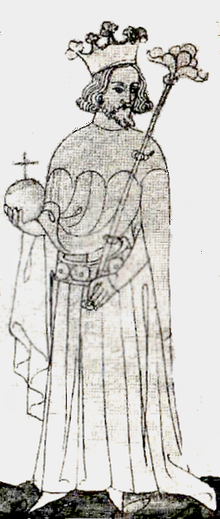


|
Beatrice of Clermont.
Otto III of Ravensberg ( c. 1246 – 5 March 1306) was Count of Ravensberg from 1249 until his death. from 1249 to 1306 Earl of.
Otto III was the son of Count Louis of Ravensberg and his wife Adelheid of Dassel. His younger brother Louis was bishop ofOsnabrück.
Hedwig of Lippe (c. 1238 – 5 March 1315), the daughter of Bernard III of Lippe.
Berthold VII, Count of Henneberg-Schleusingen (nicknamed the Wise, born: 1272 in Schleusingen; died: 13 April 1340, Schleusingen) was Count of Henneberg- Schleusingen from 1284 to 1340. He was the son of Count Berthold V of Henneberg-Schleusingen (d. 1284) and his wife Sophie of Schwarzburg (d. 1279), the daughter of Count Günther VII of Schwarzburg. He was confirmed as Imperial Prince by Emperor Henry VI in 1310.
Adelheid (1268–1317), the daughter of Henry I of Hesse.
Simon I, Lord of Lippe ( c. 1261 – 10 August 1344) ruled Lippe from 1273 until his death.
He was a son of Bernard IV and Agnes of Cleves
Adelaide of Waldeck (c. 1264 – c. 1339-1342) was a daughter of Lord Henry III of Waldeck and his wife Matilda of Arnsberg-Cuyk (also known as Matilda of Rietberg-Arnsberg).
Henry IV, Count of Waldeck ( c. 1282/1290 – 1 May 1348) was the ruling Count of Waldeck from 1305 to 1344. He was the second ruling count named "Henry", which is why some authors call him "Henry II". However, two earlier non-ruling members of the House of Waldeck are usually called Henry II and Henry III, and the subject of this article is commonly called Henry IV.
He was the eldest son of Otto I and his wife Sophie, the daughter of Landgrave Henry I of Hesse.
Adelaide of Cleves (d. after 26 July 1327)
Matilda of Mecklenburg (1293–1358):
He was the son and heir of Count Eberhard II and his wife, Irmgard of Berg
d Mechtilde ofArenberg (died March 18, 1328), daughter of Johann of Arenberg and Katharina of Jülich.
Dietrich VIII ( c. 1291 – 7 July 1347) was a German nobleman. He was Count of Cleves from 1310 through 1347.
William V, Duke of Jülich ( c. 1299 – 25/26 February 1361) was a German nobleman. Some authors call him William I, because he was the first Duke of Jülich; the earlier Williams had been Count of Jülich. Other authors call the subject of this article "William VI"; they count the son and co-ruler of William IV as William V.
Otto IV, Count of Ravensberg ( c. 1276 – 1328) was a German nobleman. He was the ruling Count of Ravensberg from 1306 until his death.
Margaret of Berg-Windeck ( c. 1275/1280 – between 1339 and 1346) was a German noblewoman.
She was the only daughter of Henry of Berg, Lord of Windeck and his wife Agnes of the Marck.

Ludwik I the Fair or Louis I the Fair also known as the Wise, the Right or of Brzeg (Brieg) ( Polish: Ludwik I Sprawiedliwy,Roztropny, Prawy or brzeski; c. 1321 – 6 /23 December 1398), was a Duke of Legnica two times: first during 1342–1345 (with his brother) and secondly during 1345–1346 (alone), and Duke of Brzeg from 1358. Also, he was regent of Legnica during 1364–1373.

Otto I of Hesse (c. 1272 –17 January 1328) was Landgrave of Hesse from 1308 until his death.
Simon II was born around the year 1270 as a son of Count John I of Sponheim and his wife Adelaide of Leiningen-Landeck


Magnus (1324–1373), called Magnus with the Necklace ( Latin: Magnus Torquatus) or Magnus II, was Duke of Brunswick-Lüneburg, ruling the Brunswick-Lüneburg principalities of Wolfenbüttel (colloquially also called Brunswick) and, temporarily, Lüneburg.
He was the eldest son of the Duke Barnim IV of Pomerania-Wolgast-Rügen and his wife, Sophie of Werle.
|
Bernabò or Barnabò Visconti (1323 – 18 December 1385) was an Italian soldier and statesman, who was Lord of Milan.
Beatrice Regina della Scala (1331 – 18 June 1384) was an Italian noblewoman, a member of the Scaliger family of Northern Italy. She was the wife of Bernabò Visconti, Lord of Milan, and the mother of his seventeen legitimate children.
Beatrice Regina was born in Verona in 1331,[1] the youngest child and only daughter of Mastino II della Scala and Taddea da Carrar
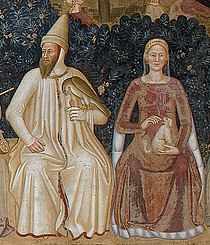
Frederick III of Baden (1327 – 2 September 1353) was Margrave of Baden from 1348 to 1353.
Johann III, Count of Sponheim-Starkenburg, the Older (b. ca. 1315 – d. 30 December 1398), reigned over the County of Sponheim for 67 years. He also received many epithets such as "the Noble" and, because of his declining vision, "the Blind".
Johann III of Sponheim was the first son of Count Heinrich II of Sponheim and Loretta of Salm
Eberhard II, called "der Greiner" (the Jarrer) (after 1315 – 15 March 1392, Stuttgart), Count of Württemberg from 1344 until 1392.
John II of Oldenburg ( German: Johann II. von Oldenburg; died c. 1314 or 1316) was Count of Oldenburg from 1275 until around 1301.
Gerhard IV ( c. 1277 – 1323), was Count Holstein-Plön from 1312 until his death.
Anastasia of Schwerin (c. 1291 – after 1316), a daughter of Nicholas I of Schwerin
As the eldest son, he succeeded his father, Albert II, as Duke of Saxe-Wittenberg after his father died on 25 August 1298. Because he was still a minor at the time, his mother acted as guardian and regent. Before this date, in 1290, he had received the County of Brehna cum annexis, which was initially administered by his mother, Agnes of Habsburg, who gradually introduced him to the business of government at the court of her brother Albert I in preparation for his rôle as ruling duke.
Margravine Jutta (Brigitte) of Brandenburg (died: 9 May 1328 in Wittenberg), a daughter of Margrave Otto V of Brandenburg.
Boček I of Poděbrady (also: Boček I of Kunštát and Poděbrady, German: Botschek I. of Podiebrad, Czech: Boček I. z Kunštátu a Poděbrad; died: 1373) was founder of the Poděbrady line of the House of Kunštát.
It is not known when and where Boček was born. Because his father, Gerhard (or Heralt) was chamberlain ( Komorník) at the courts in Brno and Znojmo,
Elizabeth of Lichtenburg (Czech: Eliska z Lichtemburka), a daughter of Henry of Lichtenburg,
Albert III of Austria (9 September 1349 – 29 August 1395), known as Albert with the Braid ( German: Albrecht mit dem Zopf), a member of the House of Habsburg, was Duke of Austria from 1365 until his death.
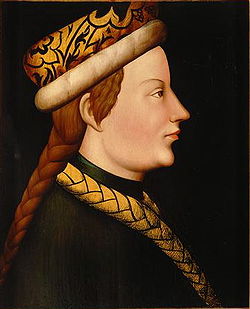

Margaret of Brieg (1342–1386) was a daughter of Ludwik I the Fair and his wife, Agnes of Sagan.


Hermann II ( Slovene: Herman; early 1360s – 13 October 1435), Count of Celje, was a Styrian nobleman and magnate most notable as the faithful supporter and father-in-law of the Hungarian king Sigismund of Luxembourg. Hermann's loyalty to the King ensured him generous grants of land and privileges that led him to become the greatest landowner in the Croatian lands. He served twice as ban of the combined provinces of Slavonia, Croatia and Dalmatia, and was recognized by a treaty in 1427 as heir presumptive to the Kingdom of Bosnia. The House of Celje's rise to power culminated in achieving the dignity of Prince of the Holy Roman Empire. Hermann was the most important representative of the line of Celje counts, having brought the family from merely local importance to the focus of Central European politics.
Anna, daughter of Count Henry of Schaunberg and Ursula of Gorizia,
Sophia of Brandenburg-Stendal (1300-1356) was a daughter of Margrave Henry I (1256–1318) and his wife Agnes of Bavaria(1276–1345).
Bernhard III, Prince of Anhalt-Bernburg (died 20 August 1348) was a German prince of the House of Ascania and ruler of the principality of Anhalt-Bernburg.
John II, Lord of Werle[-Güstrow] nicknamed The Bald (after 1250 – 27 August 1337), was from 1309 to 1316 co-regent of Werleand from 1316 to 1337 Lord of Werle-Güstrow. He was the second eldest son of John I of Werle and Sophie of Lindow-Ruppin.
John I, Duke of Mecklenburg [-Stargard] (1326 – 9 August 1392/9 February 1393), was from 1344 to 1352 Duke of Mecklenburgfrom 1344 to 1352 and Duke of Mecklenburg-Stargard from 1352 to 1392.
Anna was a daughter of the count Adolf VII of Pinneberg and Schauenburg.
|
Gerhard III of Holstein-Rendsburg ( c. 1292 – 1 April 1340), sometimes called Gerhard the Great, and in Denmark also known as Count Gert or den kullede greve ("the bald count"), was a German prince who ruled Schauenburg and Holstein- Rendsburg and during the interregnum of 1332–40 also a large part of Denmark.
Albert II (Albrecht II) Duke of Mecklenburg (c. 1318 – 18 February 1379) was a feudal lord in Northern Germany on the shores of the Baltic Sea. He reigned as the head of the House of Mecklenburg. His princely seat was located in Schwerin beginning in the 1350s.
|
Trojden I (1284/86 [1] – 13 March 1341), was a Polish prince member of the House of Piast, Duke of Czersk since 1310, ruler over Warsaw and Liw since 1313, regent of Płock during 1336–1340.
Nicholas II of Opava was a member of the Opava branch of the Bohemian noble Přemyslovci family. His parents were Duke Nicholas I of Opava, who had held Opava since 1269, and Adelheid of Habsburg, a niece of King Rudolf I
Anna of Racibórz ( Polish: Anna raciborska; b. 1292/98 – d. 1 January/21 August 1340), was a Polish princess member of the House of Piast in the Racibórz branch and by marriage Duchess of Opawa and Racibórz.
Gediminas ( Belarusian: Гедымін or Hiedymin, c. 1275 – December 1341) was Grand Duke of Lithuania from 1315 or 1316 [1][2] until his death. He is credited with founding this political entity and expanding its territory which, at the time of his death, spanned the area ranging from the Baltic Sea to the Black Sea. [3][4] Also seen as one of the most significant individuals in early Lithuanian history, he was responsible for both building Vilnius, the capital of Lithuania, and establishing a dynasty that can be traced to other European monarchies such as Poland, Hungary and Bohemia.
Grand Prince Alexander or Aleksandr Mikhailovich ( Russian: Александр Михайлович Тверской; 7 October 1301 – 29 October 1339) was a Prince of Tver as Alexander I and Grand Prince of Vladimir-Suzdal as Alexander II.
Anastasia of Halych
Ulrich III (after 1286 – 11 July 1344) Count of Württemberg from 1325 until 1344.
Ulrich was already strongly involved in politics during the reign of his father Eberhard I
Sophie of Pfirt.
In 1318 he married Valentina Doria, with whom he had three children: Matteo, Galeazzo and Bernabò, who shared the rule in Milan after his death.
Mastino II della Scala (1308 – June 3, 1351) was lord of Verona. He was a member of the famous Scaliger family of northern Italy.
Guillemette de Neufchâtel (1260–1317) was a French noblewoman, the daughter of Amadeus, Count of Neufchâtel and his wife, Jordanna of Arberg.

Otto III of Ravensberg ( c. 1246 – 5 March 1306) was Count of Ravensberg from 1249 until his death. from 1249 to 1306 Earl of.
Otto III was the son of Count Louis of Ravensberg and his wife Adelheid of Dassel. His younger brother Louis was bishop ofOsnabrück.
Hedwig of Lippe (c. 1238 – 5 March 1315), the daughter of Bernard III of Lippe.
Federico II Wettin Lobdeburg-Arnshaugk
- Nacido el 30 de noviembre 1310 - Gotha, Alemania
- Fallecido el 18 de noviembre 1349 - Wartburg, Alemania , a la edad de 38 años
Padres
Matilde de Baviera
Margrave Consorte Meissen
- Nacida el 21 de junio 1313
- Fallecida el 2 de julio 1346 - Meissen, Alemania , a la edad de 33 años
Padres
Magnus (1324–1373), called Magnus with the Necklace ( Latin: Magnus Torquatus) or Magnus II, was Duke of Brunswick-Lüneburg, ruling the Brunswick-Lüneburg principalities of Wolfenbüttel (colloquially also called Brunswick) and, temporarily, Lüneburg.
Edvige di Kyburg
Otto III, nicknamed the pious (1215 – 9 October 1267 in Brandenburg an der Havel) was Margrave of Brandenburg jointly with his elder brother John I until John died in 1266. Otto III then ruled alone, until his death, the following year.
Otto was the younger son of Albert II of the Brandenburg line of the House of Ascania and Mechthild (Matilda) of Lusatia, daughter of Count Conrad II of Lusatia,
Herman I, Count of Henneberg (1224 – 18 December 1290) was the son of Count Poppo VII of Henneberg and his wife, Jutta of Thuringia (born: 1184; died: 6 August 1235 in Schleusingen), the eldest daughter of Landgrave Herman I of Thuringia.

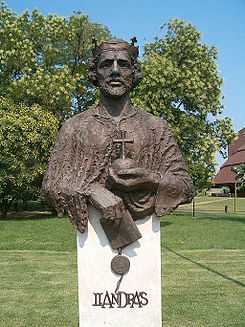




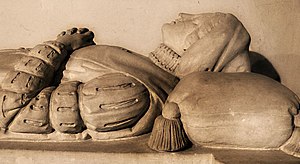
Bela IV (en húngaro: IV. Béla, croata: Bela IV., latín: Bela IV; 29 de noviembre de 1206 - 3 de mayo de 1270), rey de Hungría yCroacia desde 1235 hasta 1270 y duque de Estiria desde 1254 hasta 1258, durante cuyo reinado las invasiones de los mongolesdejaron las tres cuartas partes de Hungría en ruinas. Fue el hijo de Andrés II y Gertrudis de Merania. Derrotado a orillas del río Sajó en 1241 por los mongoles bajo Batu Kan, Bela huyó a Dalmacia, y durante un año el reino de Hungría no existió. Así cerca de la completa destrucción de su país los húngaros se refieren a esta calamidad usando la palabra tatárjárás, es decir la invasión tártara.1


|
Inizialmente era un mercante di lana, non particolarmente ricco e privo di titoli nobiliari. Abile e autorevole politico, incline alla pace, divenne vicario imperiale di Ostiglia, oltre a podestà di Cerea. Morì quasi certamente nel 1215
Mabilia della Gente, figlia di Giberto della Gente, patrizio di Reggio
|
Federico II Hohenstaufen (Jesi, 26 dicembre 1194 – Fiorentino di Puglia, 13 dicembre 1250) fu re di Sicilia (come Federico I, dal1198 al 1250), Duca di Svevia (come Federico VII, dal 1212 al 1216), re di Germania (dal 1212 al 1220) e Imperatore del Sacro Romano Impero, e quindi precedentemente Re dei Romani, (come Federico II, eletto nel 1211, incoronato dapprima ad Aquisgrananel 1215 e, successivamente, a Roma dal papa come Imperatore nel 1220), infine re di Gerusalemme (dal 1225 per matrimonio, autoincoronatosi nella stessa Gerusalemme nel 1229).
Federico nacque nel 1194 da Enrico VI (a sua volta figlio di Federico Barbarossa) e da Costanza d'Altavilla, figlia di Ruggero II di Sicilia[7], e zia di Guglielmo II, a Jesi, nella Marca anconitana, mentre l'imperatrice stava raggiungendo a Palermo il marito,incoronato appena il giorno prima, giorno di Natale, re di Sicilia. Data l'età avanzata, nella popolazione vi era un diffuso scetticismo circa la gravidanza di Costanza, perciò fu allestito un baldacchino al centro della piazza di Jesi, dove l'imperatrice partorì pubblicamente, al fine di fugare ogni dubbio sulla nascita dell'erede al trono

|
Era l'unico figlio del marchese Guglielmo VI (1170 – 1225) e di Berta di Clavesana (1180 – 1224)
Mainardo I di Tirolo-Gorizia (già Mainardo III di Gorizia) (17 gennaio 1194 – 22 luglio 1258) fu conte di Gorizia ed Istria (1220-1258) come Mainardo III di Gorizia e poi anche conte di Tirolo (1253-1258) come Mainardo I di Tirolo-Gorizia. Era figlio di Enghelberto III[1] conte di Gorizia (morto nel 1220) e di Matilde di Pisino (morta nel 1245), probabilmente figlia di Bertoldo III di Andechs.
Agnese del Palatinato

Alix de Méranie (ou Adélaïde, 1209-1279) fut comtesse de Bourgogne de 1248 à 1279 sous le nom d'Adélaïde Ire de Bourgogne.
Amédée Ier de Neuchâtel, (? - 3 février 1288)1. Co-seigneur de Neuchâtel avec ses frères Ulrich IV et Henri. Après le décès du dernier en 1283 il reste seul à la tête de la seigneurie2. Il est le fils de Rodolphe III de Neuchâtel et de Sibylle de Montfaucon, fille de Thierry III de Montbéliard3.
Siemowit I of Masovia ( Polish: Siemowit (Ziemowit) I mazowiecki) (c. 1224/28 – 23 June 1262 [1]), was a Polish prince member of the House of Piast, Duke of Czersk during 1247-1248, Duke of Masovia (except Dobrzyń) during 1248-1262, ruler over Sieradz during 1259-1260
Traidenis (Polish: Trojden, Belarusian: Трайдзень) (died 1282) was the Grand Duke of Lithuania from 1270 (or 1269) till 1282. He is the second most prominent, after Mindaugas, Grand Duke of Lithuania in the 13th century. His reign ended a seven-year unrest period after Mindaugas was assassinated in 1263 and firmly established the Grand Duchy as a pagan state for another hundred years.
- Vitas (Rumunt or Roman) who also was nicknamed as the Wolf, son of Davil Rostislavich
Casimir I of Kuyavia ( Polish: Kazimierz I kujawski) (c. 1211 [1] – 14 December 1267), was a Polish prince member of the House of Piast, Duke of Kujawy since 1233, ruler over Ląd during 1239-1261, ruler over Wyszogród since 1242, Duke of Sieradz during 1247-1261, Duke of Łęczyca since 1247 and Duke of Dobrzyń since 1248.
|
|
|
|
|
|
|
|
|























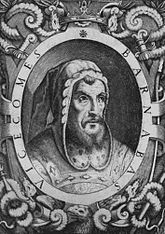











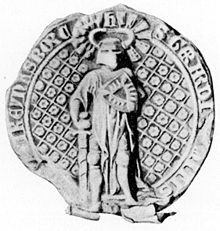







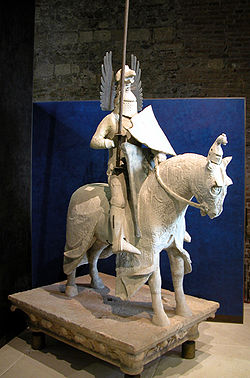
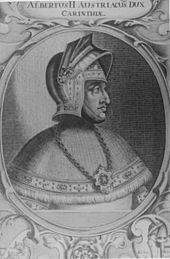


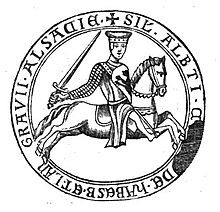






















No hay comentarios:
Publicar un comentario